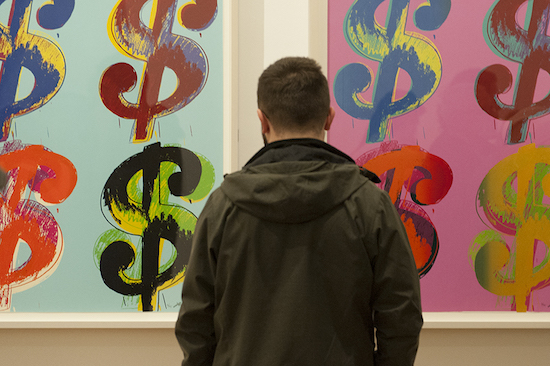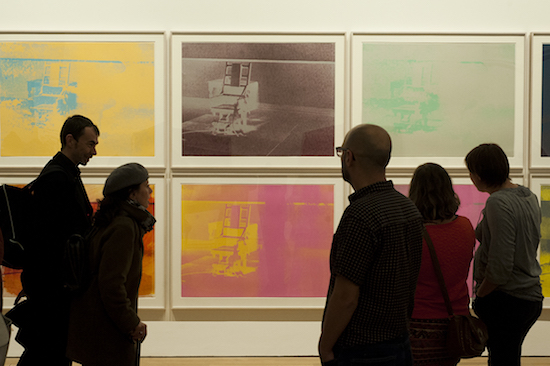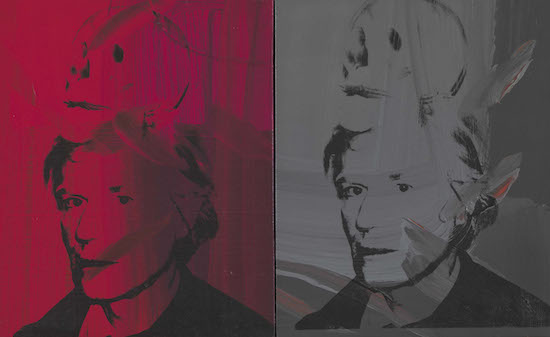Andy Warhol, Self-Portrait with Skull, 1978. Copyright the Andy Warhol for Visual Arts, Inc ARTIST ROOMS National Galleries of Scotland and Tate. Acquired jointly through The d’Offay Donation with assistance from the National Heritage Memorial Fund and the Art Fund 2008. Photo © Tate
The first thing I noticed walking into the Artist Rooms exhibition at Manchester’s Whitworth Gallery was a larger-than-life self-portrait of Andy Warhol. Staring upon the arrival of the guests, enchanting the entrance with the illusion of grandeur and himself.
This was just one of three rooms, there was one on either side of this. Whilst taking in the works of art in each room, it became evident to me the way these three rooms had been curated. The central one consisted largely of self-portraits, nodding towards the way Warhol solipsistically sandwiched himself and his art between either hemisphere of his brain, balancing his consciousness on the lines of the reality in America from the 1960s to the 80s.
Artist Rooms was founded by Anthony d’Offay in 2008 and encompasses a collection of over 1,600 works of art. D’Offay originally created Artist Rooms with the idea that “every child in the UK would have the opportunity to see great art by the time they leave school.” Since the launch of Artist Rooms in 2008, it has managed to power through the reductions in local arts funding and has inspired over 60,000 young people to take part in the learning programmes provided.
Naturally, an exhibition of the iconic works and documented legacy of Pop-Art pioneer Andy Warhol, was due.
The first and central of the Warhol Artist Rooms was a culmination of self-portraits depicting explorations of his own mortality. There were prints of him strangling himself, of skulls, and of scars from an injury he incurred from a gunshot.
In 1968 Andy Warhol was shot by a member of his entourage – a feminist author and activist named Valerie Solanas. Solanas later explained that Warhol “had too much control of my life.” The gunshot was not fatal for Warhol as he was revived by an open heart massage. All of the pieces in the central room focus on this event. They depict his recovery and his new found relish for the inevitability of his own death, whilst simultaneously powering him into an obsessive documentation of his life from this point onwards. As usual the art in this room – symbolising his fear and loss of autonomy, specifically the print of the gun and print of the skull – is colourful and contrasting in Warhol’s signature pop art palette.Amongst these portraits I found a movie poster for Warhol’s Flesh for Frankenstein in which he seems to be poking fun at his injury and the scar he obtained from the shooting.

ARTIST ROOMS: Andy Warhol at the Whitworth. Photo: Jan Chlebik
Moving from the central room to the room on the left hand side, I was met with a series of large camouflage prints in various bright, contrasting colours again. These showcased Warhol’s complicated relationship with America at the time of the Cold War, when tensions were high between the USA and the Soviet Union.
As I turned into the room I was met by a selection of black and white images, these canvases were part of the group of works Warhol created in the 1980’s called Ads and Illustration. These pieces referred to the nuclear warfare of the 1980s, including a double print of a hand full of symbolic shapes and lines referencing the atoms used to create nuclear power, a map of Eastern U.S.S.R missile bases, and another double print of a pair of army boots. The army boots, depicted in the same black acrylic paint as the hand, were styled to look almost like an item from a fashion show.
In the same room, there was another double print in the same style, however it did not obviously link to American warfare – it was just a hamburger. A hamburger with the food marketing man’s favourite words – “wholesome” and “delicious”. It comes across that Warhol’s relationship with America, it’s patriarchy and culture, is one ripe with contradictions and irony – which is what makes this group of works so thought-provoking.

ARTIST ROOMS: Andy Warhol at the Whitworth. Photo: Jan Chlebik
Warhol discusses his relationship with American politics and media in his book America. Accompanying these works, Warhol is quoted from the book: “America always begins with moods… But the trouble with the moods is that they’re always changing, sometimes really fast. And when that happens, the movies change, the babies change, the votes change, the decisions change and America flip-flops onto something totally new… That’s why the American government and the American media are so great. The President, the news magazines, television – they only want to capture America’s mood at the moment, reflect it back and tell everyone who’s not in the same mood to get over it and start feeling American like everyone else.”.
Following reading this, I shifted from the left side to the right of the exhibition, so as not to tip the boat or my brain over, and to see what was happening on the other side, in the other hemisphere.
This rooms consisted of black and white photographs of Warhol laid out on tables, diamond dust shadow paintings, photographs of other people getting about their day-to-day lives, including a blind man selling pencils with a sign saying “please buy a pencil”. These pieces related much more to the individual American than the mass of America. It felt much more candid. But, despite the mood of the rest of the room, when entering the room I was confronted with a collection of silkscreens featuring an empty electric chair that Warhol began making in 1963. The original source image derived from a 1953 newswire service photograph illustrating a debate on America’s capital punishment policy. Utilizing the pop art colour scheme recognisable from household items and advertisements, it vividly portrays Warhol’s contrasting thoughts about the way America’s mass media exploited sensitive images, through the use of contrasting colours and repetition. In this case these images were used to desensitize the public to the issue, possibly to make them more malleable to decisions made by their government.
At the end of my journey through Warhol’s Artist Rooms I left with a new perspective on the multiple levels on which Warhol created art, with the idea that he did it for himself, the individual and America – allowing the works of art to collide and feed off each other.
Artist Rooms – Andy Warhol is at the Whitworth, Manchester, until 16 April


